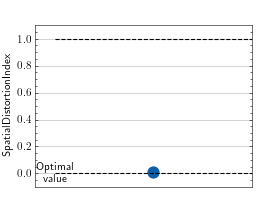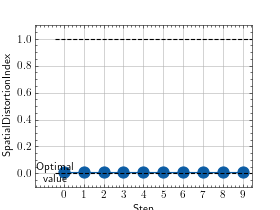Spatial Distortion Index¶
Module Interface¶
- class torchmetrics.image.SpatialDistortionIndex(norm_order=1, window_size=7, reduction='elementwise_mean', **kwargs)[source]¶
Compute Spatial Distortion Index (SpatialDistortionIndex) also now as D_s.
The metric is used to compare the spatial distortion between two images. A value of 0 indicates no distortion (optimal value) and corresponds to the case where the high resolution panchromatic image is equal to the low resolution panchromatic image. The metric is defined as:
\[\begin{split}D_s = \\sqrt[q]{\frac{1}{L}\\sum_{l=1}^L|Q(\\hat{G_l}, P) - Q(\tilde{G}, \tilde{P})|^q}\end{split}\]where \(Q\) is the universal image quality index (see this
UniversalImageQualityIndexfor more info), \(\\hat{G_l}\) is the l-th band of the high resolution multispectral image, \(\tilde{G}\) is the high resolution panchromatic image, \(P\) is the high resolution panchromatic image, \(\tilde{P}\) is the low resolution panchromatic image, \(L\) is the number of bands and \(q\) is the order of the norm applied on the difference.As input to
forwardandupdatethe metric accepts the following inputpreds(Tensor): High resolution multispectral image of shape(N,C,H,W).
where H and W must be multiple of H’ and W’.
As output of forward and compute the metric returns the following output
sdi(Tensor): ifreduction!='none'returns float scalar tensor with average SDI value over sample else returns tensor of shape(N,)with SDI values per sample
- Parameters:
norm_order¶ (
int) – Order of the norm applied on the difference.window_size¶ (
int) – Window size of the filter applied to degrade the high resolution panchromatic image.reduction¶ (
Literal['elementwise_mean','sum','none']) –a method to reduce metric score over labels.
'elementwise_mean': takes the mean (default)'sum': takes the sum'none': no reduction will be applied
kwargs¶ (
Any) – Additional keyword arguments, see Advanced metric settings for more info.
Example
>>> import torch >>> _ = torch.manual_seed(42) >>> from torchmetrics.image import SpatialDistortionIndex >>> preds = torch.rand([16, 3, 32, 32]) >>> target = { ... 'ms': torch.rand([16, 3, 16, 16]), ... 'pan': torch.rand([16, 3, 32, 32]), ... } >>> sdi = SpatialDistortionIndex() >>> sdi(preds, target) tensor(0.0090)
- plot(val=None, ax=None)[source]¶
Plot a single or multiple values from the metric.
- Parameters:
val¶ (
Union[Tensor,Sequence[Tensor],None]) – Either a single result from calling metric.forward or metric.compute or a list of these results. If no value is provided, will automatically call metric.compute and plot that result.ax¶ (
Optional[Axes]) – An matplotlib axis object. If provided will add plot to that axis
- Return type:
- Returns:
Figure and Axes object
- Raises:
ModuleNotFoundError – If matplotlib is not installed
>>> # Example plotting a single value >>> import torch >>> _ = torch.manual_seed(42) >>> from torchmetrics.image import SpatialDistortionIndex >>> preds = torch.rand([16, 3, 32, 32]) >>> target = { ... 'ms': torch.rand([16, 3, 16, 16]), ... 'pan': torch.rand([16, 3, 32, 32]), ... } >>> metric = SpatialDistortionIndex() >>> metric.update(preds, target) >>> fig_, ax_ = metric.plot()

>>> # Example plotting multiple values >>> import torch >>> _ = torch.manual_seed(42) >>> from torchmetrics.image import SpatialDistortionIndex >>> preds = torch.rand([16, 3, 32, 32]) >>> target = { ... 'ms': torch.rand([16, 3, 16, 16]), ... 'pan': torch.rand([16, 3, 32, 32]), ... } >>> metric = SpatialDistortionIndex() >>> values = [ ] >>> for _ in range(10): ... values.append(metric(preds, target)) >>> fig_, ax_ = metric.plot(values)

Functional Interface¶
- torchmetrics.functional.image.spatial_distortion_index(preds, ms, pan, pan_lr=None, norm_order=1, window_size=7, reduction='elementwise_mean')[source]¶
Calculate Spatial Distortion Index (SpatialDistortionIndex) also known as D_s.
Metric is used to compare the spatial distortion between two images.
- Parameters:
pan_lr¶ (
Optional[Tensor]) – Low resolution panchromatic image.norm_order¶ (
int) – Order of the norm applied on the difference.window_size¶ (
int) – Window size of the filter applied to degrade the high resolution panchromatic image.reduction¶ (
Literal['elementwise_mean','sum','none']) –A method to reduce metric score over labels.
'elementwise_mean': takes the mean (default)'sum': takes the sum'none': no reduction will be applied
- Return type:
- Returns:
Tensor with SpatialDistortionIndex score
- Raises:
TypeError – If
preds,ms,panandpan_lrdon’t have the same data type.ValueError – If
preds,ms,panandpan_lrdon’t haveBxCxHxW shape.ValueError – If
preds,ms,panandpan_lrdon’t have the same batch and channel sizes.ValueError – If
predsandpandon’t have the same dimension.ValueError – If
msandpan_lrdon’t have the same dimension.ValueError – If
predsandpandon’t have dimension which is multiple of that ofms.ValueError – If
norm_orderis not a positive integer.ValueError – If
window_sizeis not a positive integer.
Example
>>> from torchmetrics.functional.image import spatial_distortion_index >>> _ = torch.manual_seed(42) >>> preds = torch.rand([16, 3, 32, 32]) >>> ms = torch.rand([16, 3, 16, 16]) >>> pan = torch.rand([16, 3, 32, 32]) >>> spatial_distortion_index(preds, ms, pan) tensor(0.0090)
